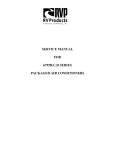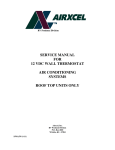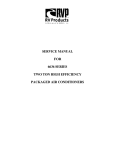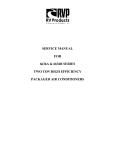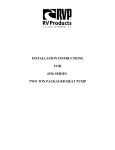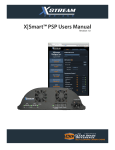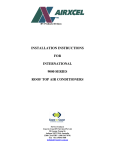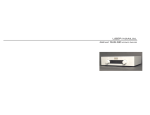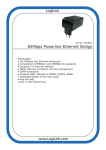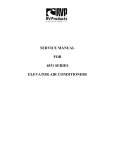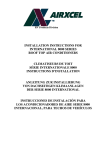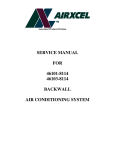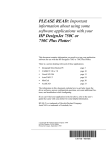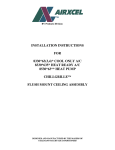Download service manual for 6537 & 6538 series two ton high
Transcript
SERVICE MANUAL FOR 6537 & 6538 SERIES TWO TON HIGH EFFICIENCY PACKAGED HEAT PUMPS TABLE OF CONTENTS 1. 2. 3. 4. 5. 6. 7. 8. 9. 10. 11. 12. 13. Warnings . . . . . . . . . . . . . . . . . . . . . . . . . . . . . . . . . . . . . . . . . . . . . . . . . . . . . . . . . . . . . . . . . . 2 Accessibility Of Appliance . . . . . . . . . . . . . . . . . . . . . . . . . . . . . . . . . . . . . . . . . . . . . . . . . . . . 3 Unit Dimensions And Specifications . . . . . . . . . . . . . . . . . . . . . . . . . . . . . . . . . . . . . . . . . . . . 3 Unit Specifications And Identification . . . . . . . . . . . . . . . . . . . . . . . . . . . . . . . . . . . . . . . . . . 3 Unit Depiction Figures . . . . . . . . . . . . . . . . . . . . . . . . . . . . . . . . . . . . . . . . . . . . . . . . . . . . . . . 4 General Information . . . . . . . . . . . . . . . . . . . . . . . . . . . . . . . . . . . . . . . . . . . . . . . . . . . . . . . . . 6 Thermostat Specifications . . . . . . . . . . . . . . . . . . . . . . . . . . . . . . . . . . . . . . . . . . . . . . . . . . . . 6 A Typical Cooling Cycle Of The Heat Pump . . . . . . . . . . . . . . . . . . . . . . . . . . . . . . . . . . . . . 10 A Typical Heating Cycle Of The Heat Pump (Electric Heat Mode) . . . . . . . . . . . . . . . . . . . 10 Wirebox Component Checkout . . . . . . . . . . . . . . . . . . . . . . . . . . . . . . . . . . . . . . . . . . . . . . . . . 11 Service Problems And Possible Solutions . . . . . . . . . . . . . . . . . . . . . . . . . . . . . . . . . . . . . . . . 12 Electrical Diagnostic Flow Charts . . . . . . . . . . . . . . . . . . . . . . . . . . . . . . . . . . . . . . . . . . . . . . 13 A. Heat Pump Operation Sequence Cooling Mode . . . . . . . . . . . . . . . . . . . . . . . . . . . . 14 A.1 No Cooling - Cooling Mode (Green L.E.D. Light Circuit) . . . . . . . . . . . . . . . . . . 15 A.2 No Indoor Blower Low Speed - Cooling Mode . . . . . . . . . . . . . . . . . . . . . . . . . . . . 16 A.3 No Indoor Blower High Speed - Cooling Mode . . . . . . . . . . . . . . . . . . . . . . . . . . . . 17 A.4 Compressor #1 Checkout - Cooling Mode . . . . . . . . . . . . . . . . . . . . . . . . 18 A.5 Compressor #2 Checkout - Cooling Mode . . . . . . . . . . . . . . . . . . . . . . . . . . . . . . . 19 B. Heat Pump Operation Sequence Heating Mode. . . . . . . . . . . . . . . . . . . . . . . . . . . . 20 B.1 No Heating - Electric Heat Mode (Green L.E.D. Light Circuit) . . . . . . . . 21 B.2 No Indoor Blower - Electric Heat Mode . . . . . . . . . . . . . . . . . . . . . . . . . . . . 22 B.3 Compressor #1 Checkout - Electric Heat Mode . . . . . . . . . . . . . . . . . . . . 23 B.4 Compressor #2 Checkout - Electric Heat Mode . . . . . . . . . . . . . . . . . . . . 24 B.5 No Reversing Valve Operation - Electric Heat Mode . . . . . . . . . . . . . . . . 25 C. Outdoor Blower Motor - Heating Or Cooling Mode . . . . . . . . . . . . . . . . . . . . . . . . 26 C.1 No Outdoor Blower Low Speed . . . . . . . . . . . . . . . . . . . . . . . . . . . . . . . . . . 26 C.2 No Outdoor Blower High Speed . . . . . . . . . . . . . . . . . . . . . . . . . . . . . . . . . . 27 Wiring Diagram . . . . . . . . . . . . . . . . . . . . . . . . . . . . . . . . . . . . . . . . . . . . . . . . . . . . . . . . . . . . . 28 1. WARNINGS IMPORTANT NOTICE ELECTRICAL GENERATORS AND INVERTERS TO “OFF” AND REMOVING THE CABLE FROM EACH POSITIVE TERMINAL ON ALL STORAGE AND STARTING BATTERIES. These instructions are for the use of qualified individuals specially trained and experienced in installation of this type equipment and related system components. CAREFULLY FOLLOW ALL INSTRUCTIONS AND WARNINGS IN THIS BOOKLET TO AVOID DAMAGE TO THE EQUIPMENT, PERSONAL INJURY OR FIRE. Installation and service personnel are required by some states to be licensed. PERSONS NOT QUALIFIED SHALL NOT INSTALL NOR SERVICE THIS EQUIPMENT. WARNING SHOCK HAZARD Improper installation may damage equipment, can create a hazard and will void the warranty. TO PREVENT THE POSSIBILITY OF SEVERE PERSONAL INJURY, DEATH OF EQUIPMENT DAMAGE DUE TO ELECTRICAL SHOCK, ALWAYS BE SURE THE POWER SUPPLY TO THE APPLIANCE IS DISCONNECTED BEFORE DOING ANY WORK ON THE APPLIANCE. THIS CAN NORMALLY BE ACCOMPLISHED BY SWITCHING THE BREAKER FOR THE AIR CONDITIONER TO “OFF”, DISCONNECTING ALL EXTERNAL ELECTRICAL CONNECTIONS AND CORDS, SWITCHING ON BOARD The use of components not tested in combination with these units will void the warranty, may make the equipment in violation of state codes, may create a hazard and may ruin the equipment. 2 2. ACCESSIBILITY OF APPLIANCE The accessibility of this appliance will vary from one installation to another. It shall be left to the service technicians judgement, the best method of attaining access to perform service. 3. UNIT DIMENSIONS AND SPECIFICATIONS PACKAGE AIR CONDITIONER MODEL NUMBER BREAKDOWN FOLLOWS: 4. UNIT SPECIFICATIONS AND IDENTIFICATION 3 5. UNIT DEPICTION FIGURES 6537 FIGURE 1 FIGURE 2 4 UNIT DEPICTION 6538 5 6. GENERAL INFORMATION This packaged heat pump mounts below the floor of the vehicle. The innovative design makes it possible to maintain a smooth, free-flowing roof line for the vehicle. It also relocates all noise and condensate drainage off the roof to below the floor of the vehicle. 1st stage (the first compressor and refrigeration circuit), will operate when: 1) The thermostat is demanding cooling or electric heating, The heat pump contains a dual compressor system. It combines the capacity of two roof mounted units into one highly efficient and compact package. 2) The vehicle is being powered by either shore line or the on-board generator. 2nd stage (the second compressor and refrigeration circuit), will operate when: Each compressor is connected to a separate refrigeration circuit. The system can be operated with a single compressor when the air conditioning requirement is low, or with two compressors when maximum performance is required. 1) This heat pump operates a two-stage system. The first compressor and refrigeration circuit is referred to as “1st Stage”. The second compressor and refrigeration circuit is referred to as “2nd Stage”. First and second stage will operate as indicated below. The thermostat senses room temperature that is 2 degrees or higher than the setpoint temperature on the thermostat. Switching and control of 1st and 2nd stage cooling is automatic. When the cooling demand does not require that both systems operate, stage two will shut down leaving stage one in operation. Heat operation always energizes both stages, however, only stage one operates if power is not available to circuit #2. 7. THERMOSTAT - 6535*3352 COLEMAN-MACH SERIES THERMOSTAT 6535*3352 THERMOSTAT OPERATION The display indicates room temperature and the word ROOM is shown on the LCD until the temperature selector is pressed; at which time the display temporarily indicates the setpoint temperature and the word SET is shown on the LCD. Each time the UP arrow is pressed, the setpoint will decrease. Once the temperature selector button is no longer pressed for a few seconds, the room temperature will again be displayed, and the word ROOM will be displayed on the LCD. In gas heat mode, the gas furnace will provide the only source of heat and the heat pump is locked out. NOTE The temperature displays in degrees Fahrenheit as a factory set default (See Figure 2). To display in degrees Celius, move the jumper marked “F” and “C” to bridge between middle pin and position “C”. In electric heat mode, if the heat pump is unable to satisfy the thermostat, DIFF will flash on the thermostat LCD when 2nd stage heating is required to satisfy the thermostat. 6 6535*3352 Heat Pump Thermostat Example To Bring On Gas Furnace As 2nd Stage Heat Setpoint 70 \\\ Indoor Temp. 70+ 69 71 69 65 71 69 65 71 69 71 \\\ 69 65 71 \\\ 69 71 Operation No functions occur Heat Pump turns on (Primary heat source) Heat Pump turns off (Thermostat satisfied) Heat Pump turns on Gas Furnace turns on (Heat Pump not able to satisfy Thermostat) (First strike for 2nd stage heat counter) Heat Pump and Gas Furnace turn off (Thermostat satisfied) Heat Pump turns on Gas Furnace turns on (Heat Pump is again unable to satisfy Thermostat), (2nd stage heat counter reaches 3rd strike and Heat Pump is locked out for 2 hours), 2nd stage heat counter is reset if Heat Pump is running for more than 20 minutes and does not call for 2nd stage heat Gas Furnace turns off (Thermostat satisfied) Gas Furnace turns on (Becomes Primary heat source) Gas Furnace turns off (Thermostat satisfied) After 2 hour lockout Heat Pump turns on (Resumes as Primary heat source) Gas Furnace turns on (Becomes Primary heat source) (Heat Pump is locked out for another 2 hours) Gas Furnace turns off (Thermostat satisfied) After 2 hour lockout Heat Pump turns on (Resumes as Primary heat source) Heat Pump turns off (Thermostat satisfied) (2nd stage heat counter is reset any time Heat Pump satisfies thermostat setpoint and does not need Gas Furnace) The word “DIFF” will flash on LCD when 2nd stage heat is operating. There is a 30 second delay between Stage 1 and Stage 2 Heat Pump operation. There is also a 3 minute anti-short cycle delay time of 3 minutes for cooling. 7 6535*3352 Thermostat Wiring 8 6535*335 2-Stage Heat Pump Thermostat Operation Table Mode Switch Fan Mode Switch Fan Speed Switch Calling Operation 1 Cool Auto Lo No 2 Cool Auto Lo Stage 1 1 Degree Above Set ID fan low, compressor #1 and OD blower low cycle as needed 3 Cool Auto Lo Stage 2 2 Degrees Above Set ID fan low, compressors #1 and #2 and OD blower high cycle as needed 4 Cool On Lo No 5 Cool On Lo Stage 1 1 Degree Above Set ID fan low continuous, compressor #1 and OD blower low cycle as needed 6 Cool On Lo Stage 2 2 Degrees Above Set ID fan low continuous, compressors #1 and #2 and OD blower high cycle as needed 7 Cool Auto Hi No 8 Cool Auto Hi Stage 1 1 Degree Above Set ID fan high, compressor #1 and OD blower low cycle as needed 9 Cool Auto Hi Stage 2 2 Degrees Above Set ID fan high, compressors #1 and #2 and OD blower high cycle as needed 10 Cool On Hi No 11 Cool On Hi Stage 1 1 Degree Above Set ID fan high continuous, compressor #1 and OD blower low cycle as needed 12 Cool On Hi Stage 2 2 Degrees Above Set ID fan high continuous, compressors #1 and #2 and OD blower high cycle as needed 13 Off Auto Lo or Hi No No functions occur in this mode 14 Off On Lo No ID fan low continuous 15 Off On Hi No ID fan high continuous 16 Gas Heat Auto or On Lo or Hi No No functions occur in this mode 17 Gas Heat Auto or On Lo or Hi Stage 1 Heater will be energized to run 18 Gas Heat Auto or On Lo or Hi Stage 2 There is no provision for 2nd stage heat when operating in the gas heat mode 19 Elec Heat Auto or On Lo or Hi No 20 Elec Heat Auto or On Lo or Hi Stage 1 Heat pump will run ID fan high, both compressors, OD fan high and both reversing valves 21 Elec Heat Auto or On Lo or Hi Stage 2 *See Note* Heat pump will run ID fan high, both compressors, OD fan high and both reversing valves plus the heater will be energized to run No functions occur in this mode ID fan low continuous No functions occur in this mode ID fan high continuous No functions occur in this mode 9 8. A TYPICAL COOLING CYCLE OF THE HEAT PUMP 1. Begins with a call from the wall thermostat for High or Low Fan (customer choice). 7. Compressor #2 starts, the outdoor fan goes off (subject to available 115 volt power supply). 2. Indoor fan starts on the selected speed. 8. Outdoor fan starts again 2 seconds later (High Speed). 3. Within a few seconds, the thermostat will call for cooling. 9. Both systems operate to satisfy the thermostat. 4. Compressor #1 starts. 10. Both compressors shut off at setpoint temperature. 5. Outdoor fan starts 2 seconds later (Low Speed). 11. When the thermostat calls for cooling again, it will start by calling for stage 1 only. 6. 1 minute later the thermostat calls for second stage cool (subject to 2 degree temperature differential). 12. If the heat pump is unable to keep up with the load, stage 2 will start again when the indoor temperature is 2 degrees above the setpoint. 9. A TYPICAL HEATING CYCLE OF THE HEAT PUMP (Electric Heat Mode) 1. Begins with a call from the wall thermostat for Electric Heat. 7. Outdoor fan starts again 2 seconds later (High Speed). 2. Indoor fan starts on High Speed. 8. Both systems operate to satisfy the thermostat. 3. Both reversing valves switch to heat mode. 9. Both compressors shut off at setpoint temperature. 4. Compressor #1 starts. 10. 5. Outdoor fan starts 2 seconds later (Low Speed). 6. 30 seconds later the Heat Pump circuit board will energize the Compressor Relay #2, Compressor #2 starts, the outdoor fan goes off (subject to available 115 volt power supply). If the Heat Pump is unable to maintain the coach temperature, the thermostat will automatically cycle the furnace on. The new True-Air Thermostats (Electric Heat Mode) will call for second stage (Furnace) heating operation anytime the temperature inside the coach is more than 5 degrees cooler than the customers chosen setpoint temperature. It is entirely possible the furnace and heat pump may both operate at the same time to satisfy the thermostat. 10 10. WIREBOX COMPONENT CHECKOUT 6537 & 6538 Model Printed Circuit Board 11 11. SERVICE PROBLEMS AND POSSIBLE SOLUTIONS COOLING MODE Problems Possible Solutions 1. Nothing Runs - Cooling Mode No A/C Voltage, No 12 VDC, Thermostat, Wiring, P.C. Board, High Pressure Switch Open 2. IDFM* Runs, No Compressor, No ODFM* Cooling Freeze Thermister - (Insufficient Indoor Air Flow), Thermostat, Wiring, Compressor, Contactor, P.C. Board 3. IDFM* Runs, ODFM* Runs, No Compressor Insufficient Voltage To Unit, Run Capacitor, Start Device, Overload, Wiring, Compressor 4. IDFM* Runs, Compressor Runs, No ODFM* Run Capacitor, Fan Motor, P.C. Board, Wiring, Fuse On Motor Black Wire 5. Compressor Runs, ODFM* Runs, No IDFM* Thermostat, Run Capacitor, Wiring, Fan Motor, P.C. Board, 6. Compressor, ODFM*, IDFM* Runs, Insufficient Cooling Air Flow Restriction, High Ambient Temperature, Undersized Refrigeration System, Very Little Or No Refrigerant Charge, Compressor 7. Compressor, ODFM*, IDFM* Runs, Unit Is Heating While In Cool Mode Thermostat, Wiring, P.C. Board, Reversing Valve HEATING MODE Problems Possible Solutions 1. Nothing Runs - Heat Mode No A/C Voltage, No 12 VDC, Thermostat, Sub-base, Wiring, P.C. Board, High Pressure Switch Open 2. IDFM* Runs, No Compressor, No ODFM* Heating Freeze Thermister, Low Outdoor Ambient Conditions, Wiring, Compressor, Contactor, P.C. Board 3. IDFM* Runs, ODFM* Runs, No Compressor Insufficient Voltage To Unit, Run Capacitor, Start Device, Overload, Wiring, Compressor 4. IDFM* Runs, Compressor Runs, No ODFM* Run Capacitor, Fan Motor, Wiring, P.C. Board, Fuse On Motor Black Wire 5. Compressor Runs, ODFM* Runs, No IDFM* Run Capacitor, Fan Motor, Wiring, P.C. Board 6. Compressor Runs, ODFM* Runs, IDFM* Runs, Insufficient Heating Air Flow Restriction, Low Ambient Temperature, Undersized Refrigeration System, Very Little Or No Refrigerant Charge, Compressors 7. Compressor, ODFM*, IDFM*, Unit Is Cooling While In Heat Mode Wiring, P.C. Board, Reversing Valve * IDFM - Indoor Fan Motor * ODFM - Outdoor Fan Motor 12 12. ELECTRICAL DIAGNOSTIC FLOW CHARTS 6537 & 6538 SERIES With the use of these flow charts, you will be able to quickly identify a non-working problem. Determine if the problem is high or low voltage and then solve the problem. To use these flow charts, start at the top left corner. Check what is indicated in that box. If the answer to what is indicated is No, work horizontally until you find the problem. When the answer is Yes or OK, work the chart downward until you locate the problem. Do Not Move Downward on any chart until all preceding steps have been confirmed good. Do Not start in the middle of any chart without knowing everything previous (upward on the chart) is OK or you may replace the wrong part. IMPORTANT NOTICE When using a jumper wire to diagnose a low voltage problem, Never Short Any Positive Terminal to Ground or the Terminal Marked “B”. Serious thermostat or p.c. board damage may occur. To prevent the possibility of severe personal injury, death or equipment damage due to electrical shock, always be sure the power supply to the appliance is disconnected before doing any work on the appliance. This can normally be accomplished by switching the breaker for the air conditioner to off, disconnecting all external connections and cords, switching on board electrical generators and inverters to off and removing the cable from each positive terminal on all storage and starting batteries. SOME DIAGNOSTIC TESTING MAY BE DONE ON ENERGIZED CIRCUITS. ELECTRICAL SHOCK CAN OCCUR IF NOT TESTED PROPERLY. TESTING TO BE DONE BY QUALIFIED TECHNICIANS ONLY. 13 12A. HEAT PUMP OPERATION SEQUENCE COOLING MODE 14 12A.1 NO COOLING - COOLING MODE NO GREEN L.E.D. LIGHT F/FY CIRCUIT TO THE THERMOSTAT 15 12A.2 NO INDOOR BLOWER LOW SPEED COOLING MODE Thermostat Set To Low Cool Note: All operating functions subject to thermostat time delays. 16 12A.3 NO INDOOR BLOWER HIGH SPEED COOLING MODE Thermostat Set To High Cool Note: All operating functions subject to thermostat time delays. 17 12A.4 COMPRESSOR #1 CHECKOUT COOLING MODE Thermostat Calling For Cooling Note: All operating functions subject to thermostat time delays. 18 12A.5 COMPRESSOR #2 CHECKOUT COOLING MODE Thermostat Calling For Cooling Note: All Operating Functions Subject To Thermostat Time Delays Note: Some coach manufacturers connect their energy management systems in series with the 12 VDC call for compressor #2. This is usually done between the output terminals on the p.c. board and the compressor #2 relay coil. 19 12B. HEAT PUMP OPERATION SEQUENCE HEATING MODE 20 12B.1 NO HEATING - ELECTRIC HEAT MODE (Green L.E.D. Light Circuit) F/FY Circuit Open To The Thermostat 21 12B.2 NO INDOOR BLOWER ELECTRIC HEAT MODE Note: Only High Fan Speed Is Energized In The Heating Mode. All Operating Functions Subject To Thermostat Time Delays. 22 12B.3 COMPRESSOR #1 CHECKOUT ELECTRIC HEAT MODE Note: All Operating Functions Subject To Thermostat And P.C. Board Time Delays. Thermostat Or Sub-base Must Be In The Electric Mode. 23 12B.4 COMPRESSOR #2 CHECKOUT ELECTRIC HEAT MODE Note: All Operating Functions Subject To Thermostat And P.C. Board Time Delays. Thermostat Or Sub-base Must Be In The Electric Mode. Note: Some coach manufacturers connect their energy management systems in series with the 12 VDC call for compressor #2. This is usually done between the output terminals on the p.c. board and the compressor #2 relay coil. 24 12B.5 NO REVERSING VALVE OPERATION ELECTRIC HEAT MODE Note: All Operating Functions Subject To Thermostat And P.C. Board Time Delays. Thermostat And/Or Sub-base Must Be In The Electric Mode. Note: If The Compressors Or Fan Motors Are Not Running, Refer To Proper Checkouts. Note: Reversing valve solenoid is energized in the electric heat mode. Once the reversing valve solenoid has energized, the p.c. board locks the valve into an energized position until the wall thermostat is placed in the cool position and actually has a demand for cooling. 25 12C. OUTDOOR BLOWER MOTOR HEATING OR COOLING MODE 12C.1 No Outdoor Blower Low Speed 26 12C. OUTDOOR BLOWER MOTOR HEATING OR COOLING MODE 12C.2 No Outdoor Blower High Speed 27 13. WIRING DIAGRAM 28 RV Products A Division of Airxcel, Inc. P.O. Box 4020 Wichita, KS 67204 1976B408 (3-06)





























